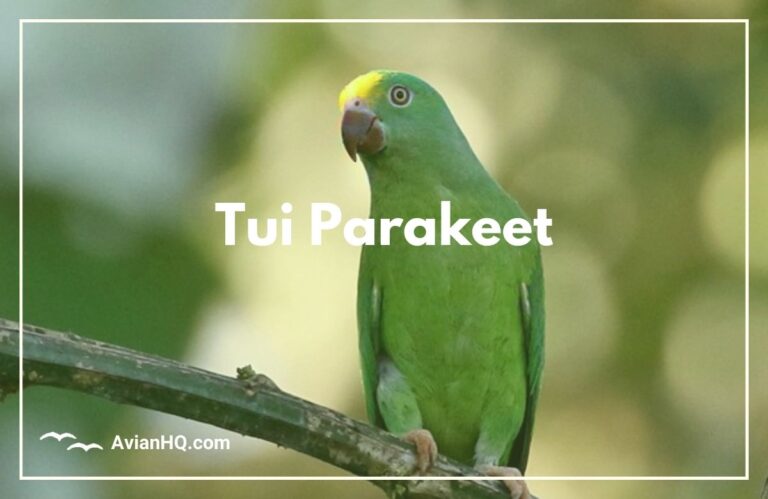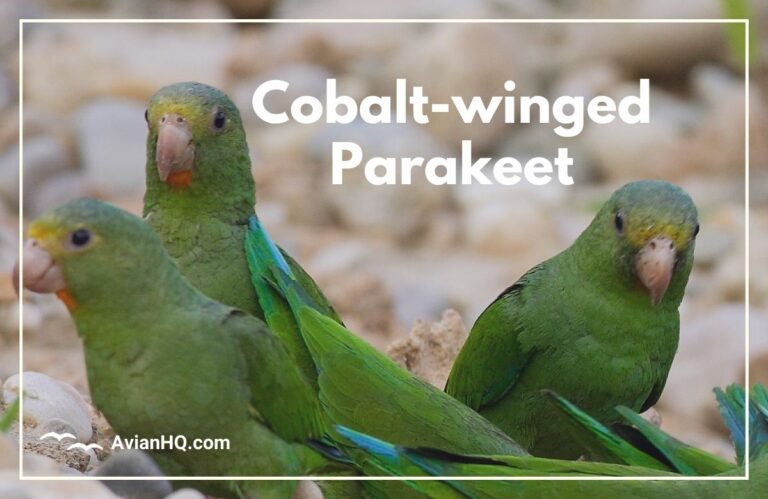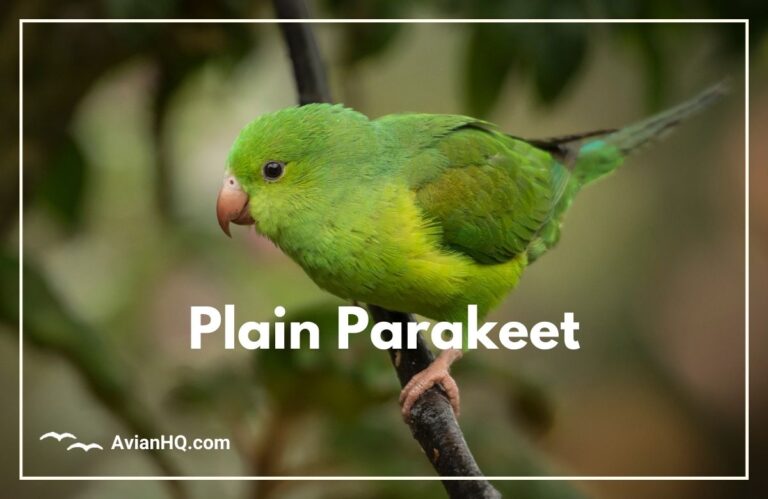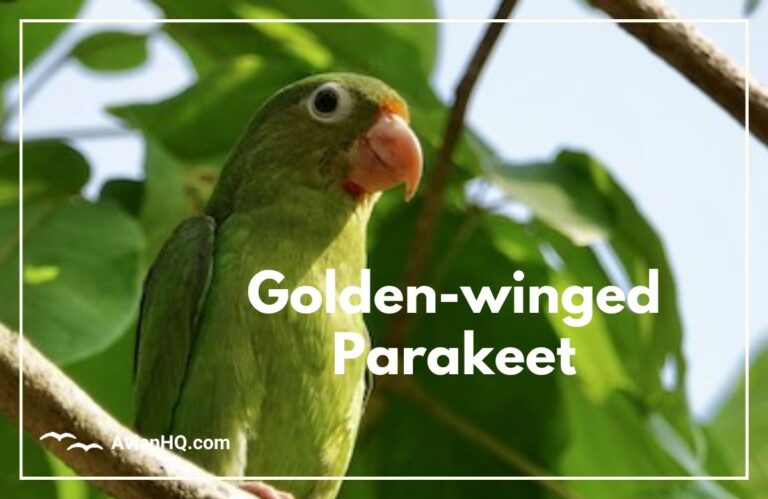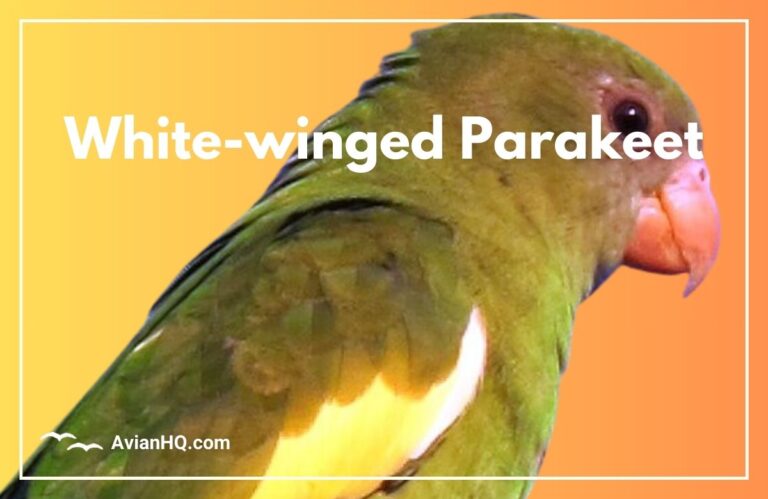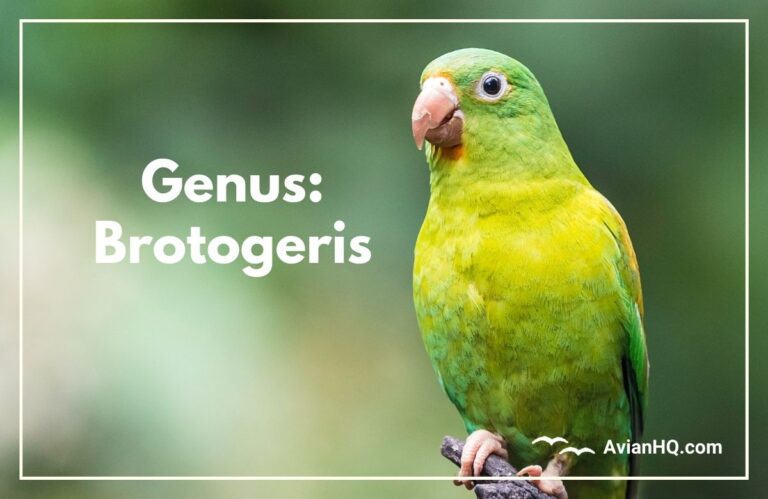Grey-cheeked Parakeet (Brotogeris pyrrhoptera)
Have you ever seen a bright green parakeet with soft grey cheeks and a red beak? If so, you may have spotted the lovely Grey-cheeked parakeet out and about. This beautiful bird lives in various parts of South America and belongs to the diverse parrot family.
At just 16 cm (6.3 inches) long, the Grey-cheeked parakeet makes its home among treetops in tropical forests and woodlands. Its bright green feathers help it blend into the lush foliage as it feeds and flies from tree to tree. When you look closely, you’ll notice its distinguishing facial markings – greyish patches around its eyes and on its cheeks. These give the bird its common name.
The Grey-cheeked parakeet is classified as a member of the genus Brotogeris. This genus contains eight total species of small, stocky parrots with short tails. The Grey-cheeked belongs to the species Brotogeris pyrrhoptera, consisting of vibrant green individuals with orange-yellow undertail feathers.
While not currently threatened, Grey-cheeked parakeet populations should be monitored since they face trapping for the pet trade in parts of their range. However, responsible breeding programs can help satisfy demands for pet parrots without threatening wild birds.
If you’re lucky enough to see one, take a moment to appreciate the splash of color a Grey-cheeked parakeet brings to South America’s green landscape. In this article, we’ll explore more about this eye-catching parrot’s traits and behaviors.
History and Taxonomy
The vibrant Grey-cheeked parakeet has a rich history as part of South America’s diverse bird life. Let’s explore some key details around its discovery and scientific classification.
First Description by French Naturalist in 1818
The first known description of the Grey-cheeked parakeet came in 1818 from French naturalist Louis Jean Pierre Vieillot. He encountered the species during his explorations of various birds of the Americas and included it in his book Nouveau Dictionnaire d’Histoire Naturelle.
Vieillot originally named the bird Psittacus pyrrhopterus, placing it in the wider parrot genus Psittacus. Over time, further taxonomic revisions reclassified the species into its current designation within the genus Brotogeris.
Part of the Wider True Parrot Family
As a parakeet, the Grey-cheeked belongs to the broad Psittacidae family of parrots, which includes over 350 species. This diverse bird group lives across the tropical and subtropical regions of the world.
Parrots in the Psittacidae family are known for their curved beaks, zygodactyl feet (with two toes facing forward and two back), and famously colored plumage. The Grey-cheeked parakeet shares these physical traits.
The Genus Brotogeris Contains 8 Species
The genus Brotogeris provides the specific taxonomic branch for the Grey-cheeked parakeet. This genus includes eight total species of small, stocky parrots with short tails adapted for forest environments.
In addition to the Grey-cheeked, some of its close Brotogeris relatives include the Tovi parakeet, Plain parakeet, and Cobalt-winged parakeet. All share vibrant green plumage accented by patches of color elsewhere on their bodies.
Considered a Monotypic Species
Within the genus Brotogeris, most authorities consider the Grey-cheeked parakeet a monotypic species with no classified subspecies. This means populations of Grey-cheeked parakeets lack defined geographic variants currently recognized by scientists.
However, future studies expanding into more remote parts of its range could potentially uncover distinct local populations that vary enough to be labeled as separate subspecies. For now though, the species consists of a single grouping all considered B. pyrrhoptera.
The Grey-cheeked parakeet has an intriguing history being discovered and described by early naturalists exploring South America’s abundant biodiversity. It carved out a distinct niche within its genus as a vibrant green parrot accented by grey cheek patches.
Physical Attributes
The Grey-cheeked parakeet’s vibrant green plumage, accented by colorful markings on its face and tail, gives this bird its distinctive look. Let’s break down key details around its size, feather markings, and other features.
Reaches About 16 cm (6.3 inches) in Length
As a small-sized parrot, the Grey-cheeked parakeet tops out around 16 cm (6.3 inches) from the tip of its tail to the end of its beak. Its short, stocky profile places it on the diminutive side of parrots.
Weighs Between 42-57 grams (1.5-2 ounces)
In terms of weight, Grey-cheeked parakeets typically range from 42-57 grams (1.5-2 ounces). Again, this puts them on the lower end of heft compared to larger parrot species that can weigh multiple pounds. Their lightweight build suits their frequent activities like climbing using beaks and feet.
Mostly Green Body Plumage
The Grey-cheeked parakeet’s back, chest, wings, top of head and parts of its face display lush green feathers typical of parrots adapted to forested tropical environments. When perched among foliage, its primary green coloration provides excellent camouflage.
Distinctive Grey Eye and Cheek Patches
As the name indicates, this parakeet has patches of pale grey feathers bordering its eyes and speckling its cheeks. These distinctive facial markings set it apart from related species. They inspired its common epithet of “Grey-cheeked.”
Yellow-Orange Undertail Coverts
While mainly green above, underneath Grey-cheeked parakeets sport vibrant yellow-orange undertail coverts – the small feathers overlaying their base tail feathers. When seen flying, these colorful undertail feathers add a flash of tropical flair.
The next time you encounter a fast-moving green parakeet with grey cheeks in South America, take a closer look to admire the Grey-cheeked’s dashing looks. Its iconic markings identify its beauty.
Habitats and Distribution
The Grey-cheeked parakeet sticks to forested tropical environments across parts of South America. It also got introduced to some Caribbean islands and Europe. Let’s explore key details about its native and non-native range.
Tightly Associated With the Amazon Basin
The Amazon basin represents the core habitat for the wild Grey-cheeked parakeet population. Numbers reach their highest in forested regions of countries like Brazil, Bolivia, Peru, Colombia and Venezuela which harbour the Amazon.
Within its home range, it occupies various lowland forest types, including humid rainforest as well as drier, seasonal woodlands. The richness of the Amazon provides an abundance of food sources and nesting cavities.
Found in Parts of the Orinoco River Basins
In addition to the Amazon, Grey-cheeked parakeets also live in tropical forests further north in parts of the Orinoco River basins in Venezuela and Colombia. Here again, vegetated habitats supply needed resources.
Introduced to Islands in the Caribbean
Thanks to the pet trade, small introduced populations of Grey-cheeked parakeets now inhabit forested areas of certain Caribbean islands like Puerto Rico and the United States Virgin Islands. Some birds likely escaped captivity.
Also Established Small Populations in Gibraltar and Portugal
Remarkably, a few groups of Grey-cheeked parakeets also managed to take up residence on the Iberian Peninsula after likely escaping from pet owners. They can be found in wooded regions of Portugal and the British Overseas Territory of Gibraltar.
Found Up to 400 Meters (1,300 feet) in Elevation
While mainly dwelling in tropical lowlands, the Grey-cheeked has been spotted up to 400 meters (1,300 feet) above sea level in mountainous areas. But it rarely strays far from its favored forested habitat.
The flexible Grey-cheeked parakeet managed to expand its distribution outside its native South America. But the lush Amazon basin remains its evolutionary home base filled with critical resources.
Diet and Feeding
The Grey-cheeked parakeet is an opportunistic forager, making use of a diverse diet. Its small but strong beak allows it to access fruit flesh, crack open seeds, and gather other nutrition from its arboreal home.
Consumes a Wide Variety of Fruit and Seeds
This parakeet is omnivorous, consuming both plant and some animal material. The bulk of its diet consists of fruits like figs, palms, and Cecropia as well as seeds which provide essential fats and protein.
It uses its curved grey bill to deftly peel fruit and break into seed hulls to access the nutritious insides. Their beaks steadily wear down from such use – growth that matches the rate of wear keeps them functional.
Also Feeds on Tree Flowers, Leaves, and Some Insects
In addition to fruit and seeds, Grey-cheeked parakeets supplement their diet by foraging on other plant parts and small prey. They occasionally snack on tree flowers, leaves, buds, along with insects and insect larvae harvested from bark crevices.
Such variety ensures a mix of nutrients to keep their energetic bodies powered. Their adaptability allows them to shift between food sources based on seasonal availability within their forest ecosystem habitats.
Typically Feeds in Small Groups and Switches Roosts
The Grey-cheeked tends to feed in small flocks numbering around 10 to 30 individuals. Feeding groups provide safety through more eyes watching for predators as they actively forage high up in tree branches.
These parakeets will switch roosting and feeding sites between days, not overusing any one cluster of trees but distributing their activity throughout their home ranges. This prevents over depletion of food resources.
With an adaptable palate and social foraging habits, the lively Grey-cheeked parakeet flourishes across its forested domain. It plays an integral role dispersing seeds and pollinating trees.
Breeding and Reproduction
When the rainy season arrives, Grey-cheeked parakeets begin pair bonding and nest building using their sturdy beaks to carve out tree holes. Let’s take a closer look at details surrounding breeding and raising their young.
Seeks Out Tree Cavities for Nest Sites
Grey-cheeked parakeets breed during the start of seasonal rains across their South American range. Pairs search tree branches for pre-existing holes, crevices, or decayed hollows that can shelter a nest chamber.
Ideal sites protect breeding pairs and their clutch from harsh sun, wind, and rain. Occasionally they excavate the soft inner wood of trees themselves to customize safe havens.
Typical Clutch Size Numbers 3-4 White Eggs
Once they establish a nesting nook, the female lays a small clutch usually numbering between 3-4 eggs. She deposits one egg every other day. These eggs have bright white shells that the parents incubate to keep developing chicks warm.
Incubation Lasts 23-26 Days
Incubation starts once the last egg gets laid, shared by both male and female parents. Chicks begin hatching after an incubation period lasting between 23-26 days. Parents attentively guard and turn eggs during this vulnerable phase.
Young Fledge Around 6 Weeks Old
Grey-cheeked parakeet chicks grow swiftly under the constant care of their doting parents. They get fed regurgitated fruit and seed mixtures until ready to venture out around 43 days old. Initial clumsy flights mark the fledging milestone into juveniles.
The Grey-cheeked parakeet’s breeding rituals hidden high up in forest trees mirrors their arboreal existence. From excavating nests to eventually fledging chicks, the canopy provides seclusion and security.
Behavior and Ecology
The Grey-cheeked parakeet thrives among the trees it calls home. Its adaptations and habits allow this energetic parrot to exploit fruiting trees and evade danger. Let’s learn more about how it lives day-to-day.
Forms Flocks of 10 to 30 Individuals
The highly gregarious Grey-cheeked is frequently found foraging, feeding, and roosting in groups called “flocks” numbering between 10 and 30 individuals. Safety and efficiency both increase through these coordinated exploits.
Flocks take advantage of having more eyes scanning for food sources and incoming predators. They prove the adage “strength in numbers” while also learning from each other.
Communal Roosts Provide Overnight Safety
Come nightfall, Grey-cheeked flock members aggregate closely together at traditional roost trees. Preferred branches have lots of leafy cover offering warmth and hiding their green forms from owls and other nocturnal predators.
Actively Forages High Up in Forest Canopy Layers
During daylight hours, flocks actively pick through upper canopy layers up to 60 feet high seeking ripening fruits and other choice morsels. Their strong legs and feet adapted for grasping let them nimbly climb vertical and sideways without issue.
Interacts Peacefully With Other Parrot Species
Grey-cheeked parakeets frequently share habitat and resources with other parrot species, including related Tovi and Plain parakeets. All manage to partition resources without hostility. However competition for nest sites occasionally flares up tensions.
Adept at living cooperatively in bustling flocks, the Grey-cheeked parakeet examines its lively world from lofty perches high up in protective forest cover searching for sustenance.
Conservation Status
Unlike many threatened parrot species, the Grey-cheeked parakeet maintains fairly stable overall populations across its range. However, some localized trapping for the pet trade bears monitoring as a potential emerging threat.
Categorized as “Least Concern” on IUCN Red List
The leading global authority on threatened species – the International Union for Conservation of Nature (IUCN) Red List – currently categorizes the Grey-cheeked parakeet as Least Concern. This means it faces no immediate higher-level extinction risk.
Current Population Likely Under 100,000 Individuals
Researchers estimate the total wild Grey-cheeked parakeet population likely numbers fewer than 100,000 individuals distributed across its wide habitat range. However, arriving at reliable estimates proves challenging.
Major Threats: Some Trapping for Pet Trade
Since Grey-cheeked parakeet populations appear generally stable, the species faces no dire major threats currently. One area that conservationists monitor includes the extent of trapping for the exotic pet trade in some areas.
Around the Amazon basin, trappers capture various parrot species to sell locally and abroad as caged birds, with a number destined for homes. If not limited, such wild bird harvesting could negatively impact Grey-cheeked numbers over time.
Protection Efforts Focus on Habitat Preservation
Protecting tracts of tropical forests that make up Grey-cheeked parakeet habitats represents the strongest conservation tactic currently. Preserving habitat ensures space and resources to allow populations to naturally fluctuate based on conditions like fire, drought, and storms.
While not imperiled presently, vigilant tracking of harvest rates for pets provides an early warning system should threats escalate for the vibrant Grey-cheeked parakeet.
Cultural Significance
The tropical beauty of the Grey-cheeked parakeet appeals to the aesthetic sensibilities of both indigenous South American cultures and modern pet owners. Its flashy feathers even inspired an aircraft paint scheme.
Appearance Inspired Indigenous Folklore
Native cultures intermingling with parrots across South America incorporated them into mythic stories and songs reflecting the contributions of their language, feathers, company, and guano. Records exist of Amazon peoples like the Matis and Mayoruna peoples maintaining Grey-cheeked individuals as pets.
Modern Demand as Captive Pets Spurs Trapping
Today the Grey-cheeked parakeet’s stunning green, grey, and orange palette fuels desires to keep it as an exotic pet. As covered earlier, trapping wild birds for sale locally and internationally persists in parts of its range. However, captive breeding helps meet legitimate pet demand.
Airline Adopted a Grey-Cheeked Paint Scheme
The Brazilian airline GOL painted one of its Boeing 737-800s in a flashy Grey-cheeked parakeet color scheme in 2010 to highlight Brazilian fauna and stand out at airports. This special livery took flight across South America and beyond sporting the parakeet’s green, yellow, grey, and red hues.
From indigenous bonds to modern marketing icons, the eye-catching beauty of the Grey-cheeked helps this tropical bird stand out as a memorable presence. While trapping requires control, peoples’ attraction to its vibrance suggests an affinity needing protection.
Conclusion
The lively Grey-cheeked parakeet has carved out an evolutionary niche across sections of Amazonia in South America. Its adaptations allowing it to exploit fruiting trees help it thrive as a distinctly-marked member of the diverse parrot family.
With a compact 16 cm body clothed in bright green plumage accented by orange-yellow tail feathers and unique grey facial patches, the Grey-cheeked parakeet aptly fits its common name. It spends daylight hours aggressively climbing about high forest canopies in gregarious flocks foraging for food.
Currently categorized as a species of Least Concern by conservation authorities, the Grey-cheeked parakeet appears to maintain stable overall population numbers, likely below 100,000 total individuals. While no dire threats loom over it presently, responsible monitoring for trapping pressures remains prudent into the future.
The Grey-cheeked also holds cultural significance for native peoples and in modern times as an eye-catching pet bird and airline branding icon. Its beauty continually captivates human observers as it zips overhead.
Hopefully this overview of the Grey-cheeked parakeet helped showcase some hidden insights and inspire appreciation for this flashy flier that brings its own tropical flair. Their importance as seed dispersers and pollinators helps perpetuate habitats hosting an abundance of biodiversity across regions they inhabit.


